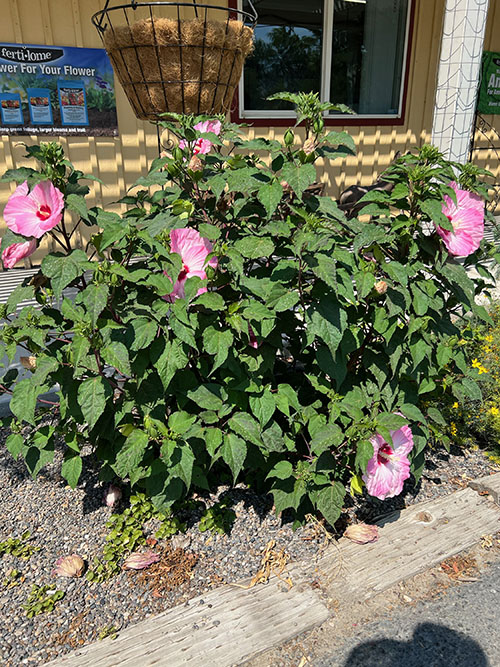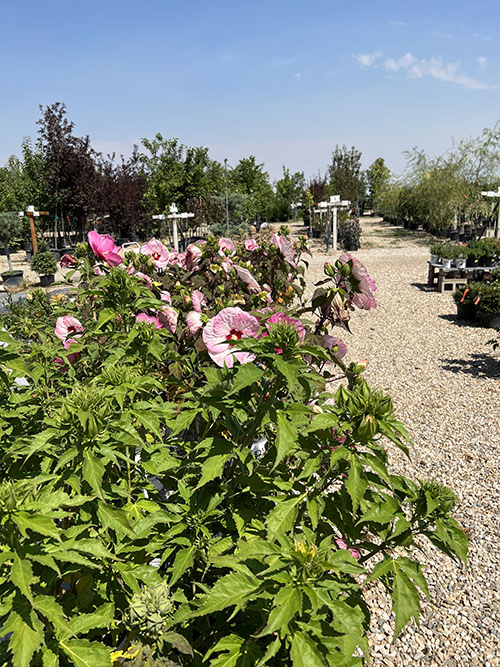Here’s a guide to get you better acquainted with the hardy hibiscus, and why you are going to want it to add some tropical flair to your garden!
Perennial gardens in the Treasure Valley could use a touch of the tropical, with the confidence that what they are planting is a plant that is native to North America. Hardy hibiscus plants are showstoppers in any garden they grace, due to their incredible huge blooms!
Your perennial garden will really pop when you incorporate the deep green foliage of what is known as the dinner plate hibiscus!
Easily confused with their very tropical hibiscus cousins, this flower can actually survive temperatures down to -30 F because they are a cold hardy hybrid! Hibiscus moscheutos can be found in the Midwest, the East Coast, Texas, and all the way to Florida and in some rain gardens, and that’s why the hardy hibiscus is so wonderful; it brings a touch of the temperate all the way to the Rockies and desert plains of Idaho.
Growing tips for your hardy hibiscus plants.
Give them plenty of room to grow.
Mature hardy hibiscus plants can grow to become 4-5 feet wide, and they grow very, very fast! It’s a good idea to keep this in mind when you are deciding where to place your hibiscus in your flower garden or yard, as you can blink, turn around and find that they have grown to twice their size in a week’s time.

They love water.
Hardy hibiscus plants love water and make a great addition to that spot in your garden that tends to flood easily. Each flower only lasts one day, but is replaced the next day by a new one. Consistent watering will help them thrive, and if you notice that they are losing their lower leaves or dropping blooms, you may want to water them more often to get them back to their optimal health. In fact, they appreciate daily watering.
If the top inch of soil is dry, they will need a drink! This is especially helpful to keep in mind during the long, hot days that we experience here in the Treasure Valley. The hardy perennial hibiscus plant makes a great addition to any ponds or other water features you have on your property due to its ability to thrive in wet areas.

Bring on the sunshine!
Hardy hibiscus will need plenty of room, and sunshine to grow. While they are very tolerant to overwatering (due to their tropical hibiscus ancestry) they are far less tolerant of shade, and will only be at their very best and showiest when they are exposed to plenty of direct sun and UV rays, around 6 hours a day.
But don’t be afraid to give your hibiscus a break from full sun, little shade (especially afternoon shade or partial shade) can be good for them as well. This is one of the other things that we love so much about the hardy hibiscus plant; they are so willing to grow and thrive in our climate with a little consideration and care.
From the ground up.
In order to grow to their full potential, perennial hibiscus plants are going to need you to prepare the soil. Wetland soils are their bread and butter, so here in the Treasure Valley, you are going to have to make sure to introduce plenty of organic material to the clay-rich variety we tend to struggle with.
If you are not sure how to prepare your soil, come into Adams Gardens and we can make sure you have everything you need for not only your hibiscus but all your other growing things too!

Garden buddies for your hibiscus.
Since the hardy hibiscus tends to bloom later in the summer garden, and may even remain dormant through May, you may want to consider planting them along with tulips, iris, or daffodils. By the time these spring favorites are all bloomed out, the hibiscus will be ready to begin its summer show. Another bonus to this garden strategy is the fact that the hibiscus foliage and blooms will camouflage the wilted and spent foliage of the iris, tulips, and daffodils.

A final surprise about the hardy hibiscus!
Did you know that perennial hibiscus species are edible? When growth emerges, the plant has edible leaves and flowers, that have a mild flavor. Flowers the size of dinner plates, on your dinner plate? What’s not to love? Also, the leaves, roots, and shoots have a gooey texture inside of them that can be whipped into a meringue, or even used to thicken soups and sauces!
We hope you have enjoyed learning more about the hibiscus, and that it has inspired you to make them a perennial part of your flower garden and backyard habitat.
